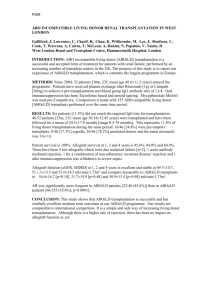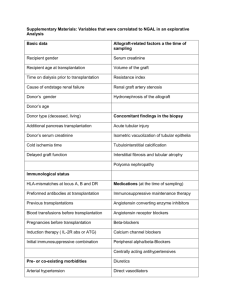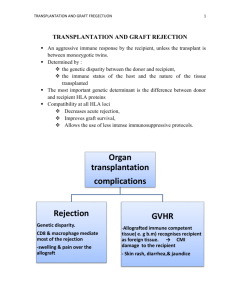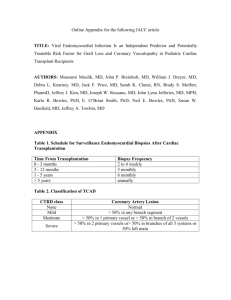RENAL TRANSPLANTATION Successful renal transplantation offers
advertisement
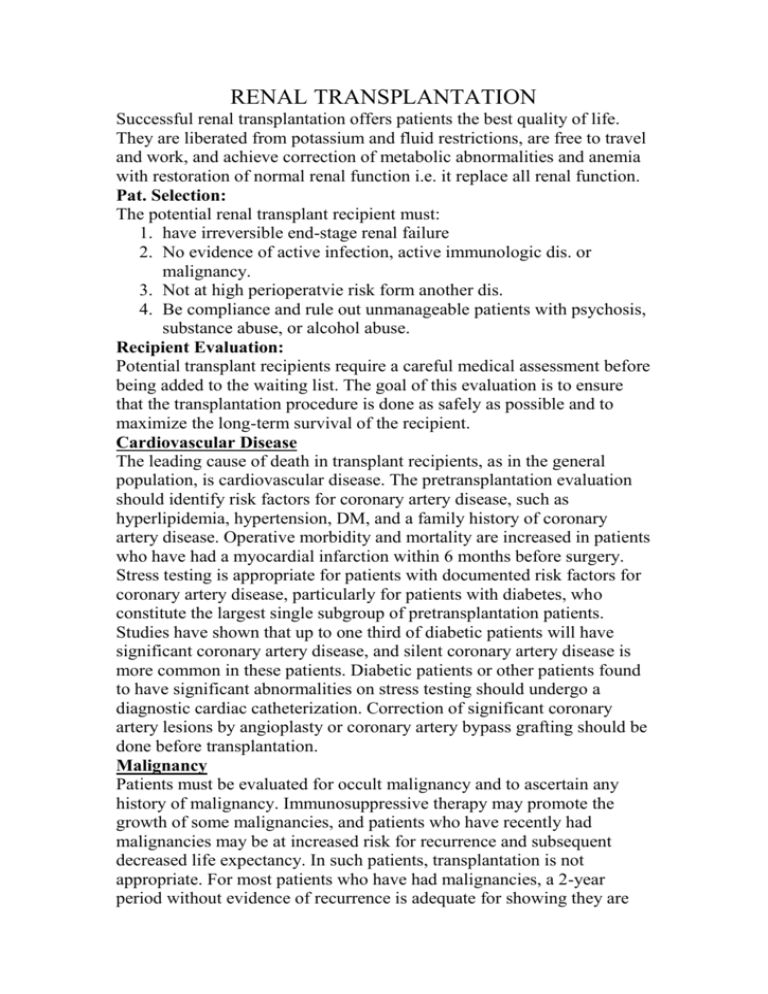
RENAL TRANSPLANTATION Successful renal transplantation offers patients the best quality of life. They are liberated from potassium and fluid restrictions, are free to travel and work, and achieve correction of metabolic abnormalities and anemia with restoration of normal renal function i.e. it replace all renal function. Pat. Selection: The potential renal transplant recipient must: 1. have irreversible end-stage renal failure 2. No evidence of active infection, active immunologic dis. or malignancy. 3. Not at high perioperatvie risk form another dis. 4. Be compliance and rule out unmanageable patients with psychosis, substance abuse, or alcohol abuse. Recipient Evaluation: Potential transplant recipients require a careful medical assessment before being added to the waiting list. The goal of this evaluation is to ensure that the transplantation procedure is done as safely as possible and to maximize the long-term survival of the recipient. Cardiovascular Disease The leading cause of death in transplant recipients, as in the general population, is cardiovascular disease. The pretransplantation evaluation should identify risk factors for coronary artery disease, such as hyperlipidemia, hypertension, DM, and a family history of coronary artery disease. Operative morbidity and mortality are increased in patients who have had a myocardial infarction within 6 months before surgery. Stress testing is appropriate for patients with documented risk factors for coronary artery disease, particularly for patients with diabetes, who constitute the largest single subgroup of pretransplantation patients. Studies have shown that up to one third of diabetic patients will have significant coronary artery disease, and silent coronary artery disease is more common in these patients. Diabetic patients or other patients found to have significant abnormalities on stress testing should undergo a diagnostic cardiac catheterization. Correction of significant coronary artery lesions by angioplasty or coronary artery bypass grafting should be done before transplantation. Malignancy Patients must be evaluated for occult malignancy and to ascertain any history of malignancy. Immunosuppressive therapy may promote the growth of some malignancies, and patients who have recently had malignancies may be at increased risk for recurrence and subsequent decreased life expectancy. In such patients, transplantation is not appropriate. For most patients who have had malignancies, a 2-year period without evidence of recurrence is adequate for showing they are not at high risk for recurrence.However, some malignancies require no waiting period, such as in situ bladder and cervical cancer, Dukes stage A colon cancer, early melanoma, basal cell skin cancer, and in situ lobular breast carcinoma. Infection Active or occult infection must be identified and treated before transplantation. Potential sources of infection include dental abscesses, infected dialysis access catheters, urinary tract infections, and tuberculosis. Patients should also have a chest x-ray, & purified protein derivative (PPD) testing for TB. HIV-positive recipients In the past, HIV-positive patients with end-stage renal disease were excluded from consideration for transplantation. With the advent of highly active antiretroviral therapy, many of these patients have very prolonged survival & can under go transplantation. Patients with AIDS and low CD4+ T cell counts are not at this time considered for transplantation. Some immunosuppressant medications appear to have antiretroviral properties. Hepatitis C The prevalence of hepatitis C is high in the dialysis patient population. Studies have shown that hepatitis C-positive recipients have an increased risk of liver disease after transplantation. Patients identified as carriers of hepatitis C should undergo a pretransplantation liver biopsy to assess the degree of histologic disease. Patients with evidence of advanced disease are not candidates for kidney transplantation, although they may be considered for combined kidney-liver transplantation. Hepatitis B Patients should be screened for evidence of hepatitis B infection. Transplantation is not contraindicated for patients who are positive for surface antigens as long as there is no evidence of advanced liver disease; however, patients must be screened for evidence of active viral replication with hepatitis B e antigens or with hepatitis B DNA. Patients who have active replication are at higher risk for disease progression after transplantation and generally do not receive transplants. Primary renal disease Patients with end-stage renal disease who have a primary glomerulopathy are at risk for disease recurrence in the transplanted organ. If possible, the glomerulopathy should be identified before transplantation because the recurrence rates vary with specific diseasesas shown: 1. Membranous nephropathy 2. IgA nephropathy 3. Focal segmental glomerulosclerosis 4. Type I membranoproliferative glomerulonephritis 5. Type II membranoproliferative glomerulonephritis 6. Glomerular basement membrane disease As a general rule, primary glomerular diseases recur relatively commonly, but graft losses secondary to recurrence are uncommon; renal transplantation is not contraindicated in patients with primary glomerulonephritis. Patients at highest risk are those whose original disease was aggressive and rapidly caused the loss of renal function. In this setting, recurrent disease can occur immediately after transplantation, and graft loss may be high. Living-donor transplantation may be relatively contraindicated. Medical Compliance and Substance Abuse Patients on dialysis who have a history of multiple episodes of medical noncompliance can receive transplants successfully. However, these patients need extremely close follow-up. Patients with a history of drug or alcohol abuse should show evidence of participation in a rehabilitation program and successful avoidance of drugs and alcohol for 6 months. A substance-abuse screen is useful to document abstinence. Neither psychiatric illness that is controlled with active treatment nor mental retardation is an absolute contraindication to transplantation. TIMING OF TRANSPLANTATION Ideally, the transplantation evaluation should be initiated early in the management of chronic renal disease. Preemptive transplantation that is, transplantation before the initiation of long-term dialysis has been shown to result in improved patient outcome. Patients who have received a living-donor kidney before the initiation of long-term dialysis have shown a substantially reduced risk of allograft failure for the first year and subsequent years after transplantation. Living-Donor Evaluation Currently, almost one half of the organ transplantation procedures done in the United States are living-donor transplantations. The percentage of living-donor organ transplantations has increased substantially in recent years, in part because of the well-documented success of transplantation using kidneys from living donors who are not biologically related to the recipient and because of the widespread use of laparoscopic donor nephrectomy. Longitudinal studies have demonstrated conclusively that in healthy individuals, kidney donation is safe and does not result in progressive loss of renal function. Over time, donors may experience a slight rise in blood pressure, but the clinical consequences are minimal. The donor surgical procedure has a good record of safety. Studies suggest a mortality of approximately 0.03% and a complication rate of perhaps 2% to 10%. The common postsurgical problems associated with traditional open nephrectomy techniques are hemothorax, pneumonia, pneumothorax, and wound complications. Laparoscopic donor nephrectomy is very well tolerated by donors and results in a shorter hospital stay and a quicker return to work. MEDICAL SCREENING AND BLOOD TESTING The preliminary workup of a potential kidney donor should include a general medical screen for obvious contraindications, such as hypertension and diabetes mellitus. Medical screening should be followed by the assessment of the donor and recipient blood groups and a crossmatch between donor and recipient; ABO compatibility is usually required for successful transplantation. Tissue typing is performed to determine the degree of HLA matching between donor and recipient. The degree of HLA matching has an important effect on long-term outcome and may affect donor selection when multiple potential donors are available. The best long-term outcomes are obtained between two haplotype-matched siblings, although excellent results are possible with lesser degrees of HLA matching. A crossmatch is also performed between the donor and recipient to detect preexisting antibody sensitivity against donor antigens in the recipient. A positive crossmatch generally precludes proceeding with transplantation because, in such circumstances, there is a high risk of hyperacute rejection. ABO incompatibility or a positive crossmatch between donor and recipient previously was considered a contraindication for transplantation; however, new techniques have been developed to allow successful transplantation in some cases of ABO mismatch or positive crossmatch. These techniques generally utilize plasmapheresis to remove preformed recipient antibody and are combined with pretransplant immunosuppression to inhibit antibody formation. Initial results have been good, and these techniques are being more widely applied. LABORATORY TESTS If ABO compatibility and a negative crossmatch are documented, evaluation of the prospective donor can proceed. Clinical testing of the potential donor should include a complete blood count, chemistry screen, urinalysis, urine culture, and coagulation studies. A 24-hour urine collection should be done to assess for creatinine clearance and any evidence of protein excretion. Serologic testing should include antibodies to HIV, CMV, EBV, and hepatitis B and C. In addition, a chest x-ray, an ECG, and a PPD skin test should be performed. Contraindications to live donation include impaired kidney function, significant nonorthostatic proteinuria (> 200 mg/24 hr), active malignancy, active substance abuse, severe chronic illness, and pregnancy. ARTERIAL IMAGING A careful assessment of arterial anatomy of the kidney donor is essential. In the past, this assessment required formal contrast angiographic studies. Currently, magnetic resonance angiography is enough. SCREENING FOR INHERITED RENAL DISEASE On occasion, the etiology of the renal disease in the recipient is unknown. In such circumstances, a detailed history must be obtained from the donor to determine whether there is evidence of familial renal disease. Polycystic kidney disease is the most common hereditary kidney disease PSYCHOLOGICAL ASSESSMENT Donors' motivation should be assessed to ensure that donations are voluntary and that donors have a good understanding of the potential outcomes for both themselves and the recipients. Kidney donation appears to provide psychological benefit for most donors. However, potential donors need to be aware that the outcome for the recipient cannot be guaranteed. The technique: it involves the anastomosis of an explanted human kidney, usually either from a cadaveric donor or from a living close relative, on to the iliac vessels of the recipientin the iliac fossa subcutaneouslu to be easily acceible for biopsy in case of rejection,the donor ureter is placed into the recipient's bladder IMMUNOSUPPRESSION Clinical immunosuppression is an empirical practice to provide prophylaxis against rejection without harming the patient or the graft. Inadequate immunosuppression results in rejection of the transplanted organ, whereas overimmunosuppression can lead to immunodeficiency, infection, and, possibly, malignancy. Class Corticosteroids: Prednisone Antimetabolites: azathioprine Mycophenolate mofetil Drug 1- Cyclosporin 2- Tacrolimus TOR inhibitor 1- Sirolimus 1- ATGAM Polyclonal antibodies 2- RATG 1- OKT3 Monoclonal antibodies 2- Anti-CD25 3- Basiliximab 4- Daclizumab ATGAM-antithymocyte globulin RATG-rabbit antithymocyte globulin TOR-target of rapamycin Induction Immunosuppression The multiagent strategy allows for a synergistic effect and reduction of specific drug toxicity,immunosuppression is initiated at high doses during Calcineurin inhibitors the initial period after transplantation, when the risk of rejection is highest, In recipients with a high risk of rejection (children, retransplant recipients, delayed graft function, multiparous women, and multitransfused patients), induction immunosuppression is often employed. Induction therapy consists of a course of (1) polyclonal antilymphocyte-antithymocyte globulin (ATG) or antilymphocyte globulin; (2) monoclonal anti-CD3 antibodies (OKT3); or (3) anti– interleukin-2 receptor monoclonal antibodies (basiliximab or daclizumab). Appropriate antiviral prophylaxis is essential to reduce the risk of severe cytomegalovirus (CMV) infection and Epstein-Barr virus (EBV)–associated post-transplantation lymphoproliferative disease. Likewise, prophylaxis with trimethoprim sulfamethoxazole has been effective in preventing urinary tract infections as well as Pneumocystis carinii (now Pneumocystis jiroveci) infection in these highly immunosuppressed patients. Maintenance Immunosuppression Many immunosuppressive agents are available for prevention of rejection in the maintenance lower doses, Common regimens consist of low-dose steroids, mycophenolate mofetil, or azathioprine plus a calcineurin inhibitor (either cyclosporine or tacrolimus). Posttransplantation Complications: 1- Rejection Rejection remains the Achilles heel of transplantation, and acute rejection is the most important predictor of chronic rejection. The introduction of cyclosporine in the early 1980s and mycophenolate mofetil in the 1990s has significantly reduced the incidence of rejection, producing a significant increase in allograft survival. Allograft rejection is initiated by the recipient's recognition of donor MHC antigens, leading to activation of humoral and cellular immunity. Types of rejections: 1- Hyperacute humoral rejection is a rare clinical event; however, when it occurs, it usually causes immediate irreversible necrosis of the allograft on the operating table. It caused by preformed alloantibodies in the recipient directed against donor HLA or ABO antigens, and this form of antibody-mediated rejection can usually be prevented by careful crossmatching techniques. 2- acute :cell mediate rejection seen in the 1st month ,the clinical manifestations of acute cellular rejection may include fever, allograft swelling and tenderness, or oliguria. The BUN and creatinine concentrations are usually elevated. A Doppler ultrasound study should be performed to rule out obstruction and vascular thrombosis. The diagnosis of acute rejection can be reliably made only with an allograft biopsy. All other potential causes of acute allograft dysfunction should be considered 3- subacute :also cell mediate seen in the 1-3 months 4- chronic :it is graft loss i.e. chronic rejection 2- ACUTE AND CHRONIC RENAL TRANSPLANT DYSFUNCTION The causes of acute or chronic renal dysfunction in the long-term renal transplant recipient should be carefully evaluated. Dysfunction can be related to vascular, structural, or renal parenchymal disorders or to volume depletion Category Causes Extrinsic compression (fluid collection) Structural Ureteral obstruction (stone, scarring, mass) Urethral obstruction (prostate, stricture) Vascular Renal artery stenosis Volume depletion Cardiac failure Diuretics Acute rejection Renal parenchymalChronic rejection Recurrent glomerulonephritis ACE inhibitors Angiotensin II receptor blockers Drugs Antibiotics Calcineurin inhibitors NSAIDs Structural disorders A renal sonogram can be very helpful in elucidating the location of a potential obstruction. An appropriate radiologic or urologic intervention can be made to relieve the obstruction. Vascular disorders: Radiographic imaging techniques, such as duplex ultrasound and magnetic resonance arteriography, are critical to rule out this process. Renal artery stenosis of the transplanted kidney typically requires percutaneous transluminal angioplasty or surgical correction. Renal parenchymal disorders A percutaneous allograft biopsy with careful tissue examination by light microscopy, electron microscopy, and immunofluorescence is critical to making the correct diagnosis. Although recurrent kidney disease can occur and, in selected cases, may result in progressive loss of renal function, it is much less likely to occur than acute rejection or chronic allograft nephropathy. 3- POSTTRANSPLANTATION INFECTIONS the occurrence of posttransplantation infections fall into three periods: A- In the first month after transplantation, the most common infections are those resulting from complications of the surgical procedure, such as wound infections, catheter-related urinary tract infections, aspiration pneumonia, and infections of hematomas or lymphoceles. Occasionally, infections may be transmitted by the allograft. B- After the first month, the spectrum of infection changes. The high dose of immunosuppressive drugs used early in the transplantation procedure places the patient at risk for a variety of opportunistic bacterial, fungal, and viral infections from such organisms as Nocardia, Aspergillus, Cryptococcus, and Candida. The activation of latent viral infections from such pathogens as CMV, EBV, and varicella also pose a threat during this period. C- Six months after transplantation, most immunosuppressive medications have been reduced to relatively low levels. Communityacquired respiratory infections from pneumococcal, influenzal, and other respiratory pathogens are more common than opportunistic viral or fungal infections. 4- Malignancy The incidence of tumors in patients on immunosuppressive therapy is 5– 6%, or approximately 100 times greater than that in the general population of the same age range. The most common lesions are cancer of the skin and lips and carcinoma in situ of the cervix, as well as lymphomas such as non-Hodgkin's lymphoma. The risks are increased in proportion to the total immunosuppressive load administered and time elapsed since transplantation. Surveillance for skin and cervical cancers is necessary. MANAGEMENT OF COEXISTING DISEASE Hypertension: it can be a pretransplant condition as well as a complication of transplantation,some immunosuppressive medications such as cyclosporine and corticosteroids can caused hypertension graft dysfunction can also worsen the hypertensive process. Renal artery stenosis occurs infrequently but should be considered if blood pressure control is resistant to therapy or renal function worsens as blood pressure is better controlled. there is a direct correlation between systolic blood pressure and graft half-life. A systolic blood pressure near 120 mm Hg is optimal for prolonging graft function. As in patients with native renal disease, drugs that block the renin-angiotensin system should be routinely employed as part of a multidrug strategy to improve blood pressure control. ACE inhibitors and angiotensin II receptor blockers provide better control of glomerular capillary pressure and proteinuria than do other commonly used drugs. This effect may be important in stabilizing renal function and preventing loss of graft function. These drugs may also produce blood pressure-independent benefits by attenuating glomerular scarring and interstitial fibrosis. Physicians frequently avoid these drugs because of concerns about increases in potassium or serum creatinine levels, which could be misconstrued as indicating rejection. These drugs can be used safely, especially 3 to 6 months after transplantation, when the risk of rejection is markedly reduced. Hyperlipidemia it related to immunosuppressive drugs given in combination, particularly corticosteroids and cyclosporine. Newer medications, such as sirolimus, may also adversely affect lipid profiles. Frequently, lipid abnormalities will improve within 3 to 6 months after transplantation, as the doses of immunosuppressants are reduced. However, there is a clear association between cardiovascular disease and posttransplantation hyperlipidemia that needs to be considered. Progressive vascular disease in the form of atherosclerosis can occur in the graft as chronic vasculopathy . dietary measures are insufficient to control lipid abnormalities, and frequently, the use of HMG-CoA (3-hydroxy-3-methylglutaryl coenzyme A) reductase inhibitors (statins) are necessary. Although some early reports indicate that higher doses of statins have the potential to cause rhabdomyolysis, particularly in combination with cyclosporine Diabetes Mellitus Posttransplantation diabetes mellitus occurs de novo in 4% to 20% of patients.Many of the immunosuppressive agents, particularly corticosteroids and tacrolimus, cause or exacerbate posttransplantation diabetes. Cyclosporine may also be diabetogenic. Efforts designed to improve glycemic control may be helpful in reducing the likelihood of progressive vasculopathy in the transplanted kidney. Minimizing or stopping corticosteroid therapy can markedly improve glycemic control. Diabetogenic agents such as tacrolimus can be replaced with nondiabetogenic immunosuppressants such as sirolimus. Ideally, glycated hemoglobin (HbA1c) should be reduced to less than 7%; this results in fewer cardiovascular events and a reduction of diabetic target organ damage. Hematologic Conditions Hematologic conditions are usually caused by immunosuppressants or excessive blood draws. Anemia and leukopenia are not uncommon. Many of these conditions can be corrected with vitamins, iron, folate, and reduced doses of antimetabolites or reduction in the frequency of blood draws. Parvovirus infection can also cause anemia, and inadequate renal function may require concomitant use of erythropoietin. Infection with parvovirus B19 can be diagnosed by changes in serology or by detection of the parvovirus genome in sera or bone marrow by polymerase chain reaction. Leukopenia can be caused either by infection, such as CMV, or by medications, such as azathioprine or mycophenolate mofetil. Drugs that block the renin-angiotensin system, such as ACE inhibitors or angiotensin II receptor blockers, may also cause a 10% to 20% reduction in hematocrit. Erythrocytosis may develop in 10% to 15% of renal transplant recipients. Repeated phlebotomy or use of ACE inhibitors or angiotensin II receptor blockers or theophylline can normalize the hematocrit in most patients.

